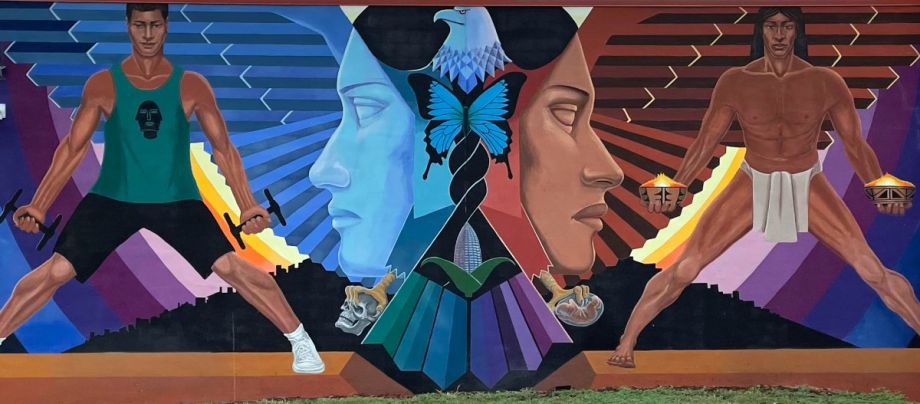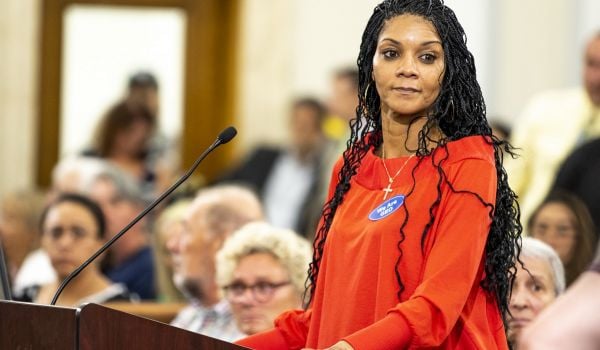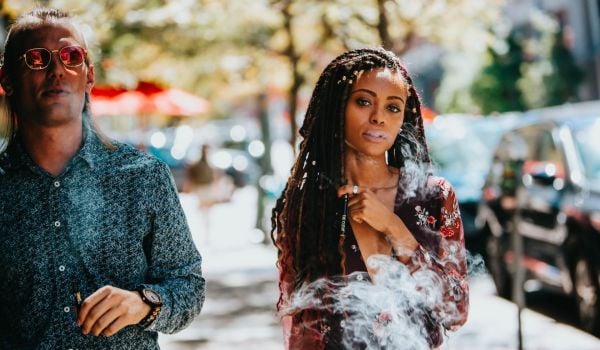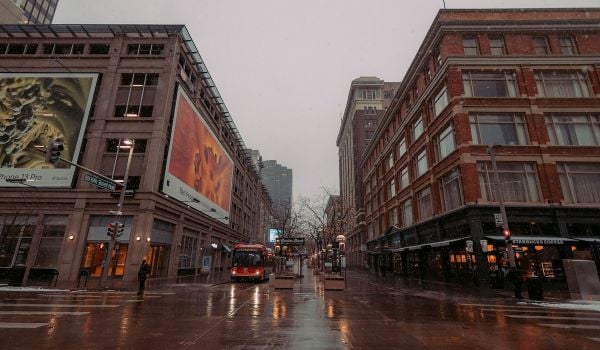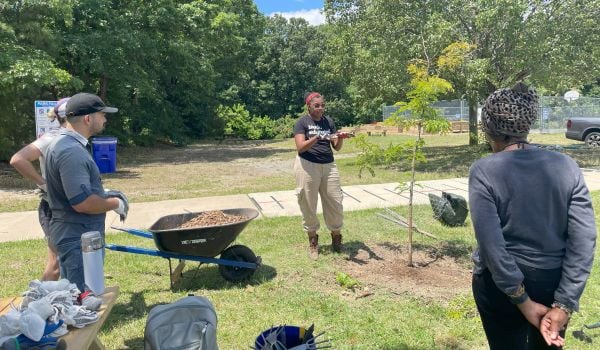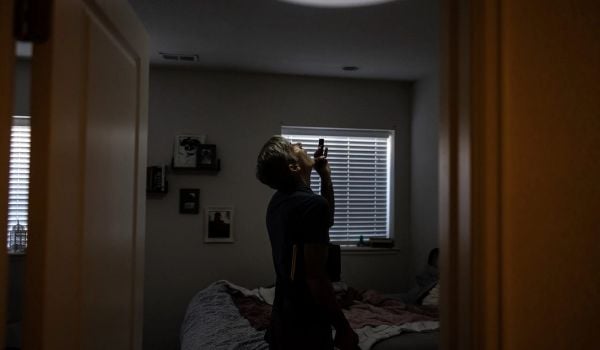Lucha Martinez de Luna was baptized in front of a mural her father painted in Denver’s La Alma Lincoln Park, over an altar her father originally created for a mass in California where Cesar Chavez ended his 25-day hunger strike in protest against unfair employment practices and unsuitable work conditions for migrant laborers.
During a wave of so-called “urban renewal” in 1970s Denver, that mural was destroyed. But the altar is now in the Smithsonian. And her father, Emanuel Martinez, is recognized today as the pioneer of the Chicano mural movement across the country, which started with his murals in La Alma.
And Martinez de Luna today knows better than most about the significance of preserving history and culture. She’s now a trained archaeologist, excavating a 4,000 year-old city near Chiapas, Mexico.
“I travel back and forth to Chiapas and Denver every 6 months,” Martinez de Luna says. “And every time I come home, because that’s how rapid the gentrification and displacement is happening here, another part of the area where I grew up, buildings that I remember, murals that I remember growing up, were either sandblasted or whitewashed or the buildings were knocked down.”
The city of Denver is now at the final stages of approving the creation of the La Alma Lincoln Park Historic Cultural District. The Denver Landmark Preservation Commission voted unanimously to advance the proposal earlier this month. The final say lies with Denver City Council, which is scheduled to vote in August.
“It is definitely a nod and acknowledgment to all of that history that came with this neighborhood; it really helped create a lot of the influence that you see today for the Latino community for cultural marks, for murals, for politics,” Council Member Jamie Torres, who represents the area, told The Denver Post in May. “There are roots right there in that neighborhood.”
Martinez de Luna says it would be the first historic district across the country created in honor of the Chicano movement. In practical terms, it would provide stronger protections for nearly 200 structures in the designated area, mostly single-family homes but also community buildings and other structures like the Denver Inner City Parish building and the recreation center in La Alma Lincoln Park — both of which have historic murals, the latter painted by Martinez de Luna’s father in 1978 to replace the one that was previously destroyed.
“It’s also, I hope, building awareness and giving us an opportunity to tell our story,” says Martinez de Luna. “It’s giving us a little bit of a platform. And that sense of space again — the first people that occupied this area, the indigenous campgrounds that were along the Platte River, that story is also told in the murals.”
Work toward the proposed La Alma Lincoln Park Historic Cultural District began back in 2016. That’s when a few more recently arrived residents of La Alma first approached Historic Denver, the main historic preservation group in the city. The residents applied to the Historic Denver Action Fund, which selects two to three neighborhood-driven projects a year on a rolling basis, providing them with technical assistance, staff support and some funding.
The Historic Denver Action Fund paid for a consultant to author a deeply researched historical context for the area that is now La Alma, going back to the 19th century. Until the 1850s, the “land was the site for occasional and seasonal encampments of several Native tribes, including the Arapaho, Cheyenne, Ute Mountain Utes, and others,” according to the historical context. Gold was discovered in the South Platte river in 1857, attracting mining companies and workers — La Alma stands today as Denver’s oldest residential neighborhood.
Many of the bungalow-style homes still standing in the neighborhood today date back to that era, though they were significantly altered during a wave of Chicano arrivals to the neighborhood in the 1950s and 1960s. Chicano families added new siding or stucco over the original brick to address maintenance issues or to match their sense of style. Many added short fencing to front yards.
Those late 19th century houses in La Alma have mostly retained their original basic architectural forms, and the proposed historic cultural district aims to protect those forms as they were altered by Chicano arrivals in the mid-20th century. More modern construction already dots the neighborhood today, with some residences combining adjacent lots into larger structures.
“They’ve knocked down a few beautiful houses,” says Cathy Prieto, a La Alma resident and former member of the Brown Beret, a Chicano youth movement with chapters in dozens of cities.
Prieto still lives in the house her parents purchased in 1959. She once joined her classmates at the neighborhood’s West High School to walk out one day in protest of racist insults by a teacher that did not elicit any response from administrators. That walkout, in 1969, sparked Chicano youth across the city to march to La Alma Park (then still officially named Lincoln Park) in what became known as the “Blowout.” That history, too, is memorialized in surviving murals in La Alma.
“The murals function as our historical textbooks,” says Martinez de Luna. “We are barely being represented in the schools. For the most part they talk about Cesar Chavez, which is fine, but they rarely talk about the movement here.”
Working with established and newer neighborhood groups, Historic Denver also supported a handful of feedback sessions with community members to share the historical context findings and collect more oral histories and perspectives.
And, “we asked what do people want to see for the neighborhood,” says Shannon Stage, manager of grants and preservation services at Historic Denver. “We also shared what tools could be used, what tools exist within the city of Denver that could support their goals.”
Creating a historic cultural district for La Alma came up as part of those discussions. Denver has 56 historic districts, covering 6,800 buildings. Generally speaking, the main distinction between historic districts and historic cultural districts in Denver is that historic districts come with generalized historic design guidelines that govern changes that can be made to building exteriors, while historic cultural districts have custom design guidelines that refer to specific architectural styles or features within the district that must be protected.
There is one existing historic cultural district in Denver — covering the Welton Street corridor in the Five Points neighborhood, Denver’s historic Black cultural hub. Designated in 2002 and updated with a new name and custom design guidelines in 2016, in some ways it was already too late — white residents already outnumbered Black and Latino residents combined in Five Points.
Although there are still some holdouts, like Prieto, it may also be too late to protect the bulk of La Alma’s historic Chicano residents. Prieto and other long-time residents say they are bombarded with offers to buy their houses for cash.
“A lot of people had to leave because they can’t afford the property taxes in Denver,” Martinez de Luna says. “I hate to say it but the reality is most of the [La Alma Chicano families] aren’t there any more. I am definitely for the historic cultural district, but I also feel like it’s memorializing us and gives Denver a chance to say ‘oh we protected one of your neighborhoods.’ There were so many Chicano neighborhoods in Denver but really La Alma is the last one.”
Even if the historic cultural district is created, there’s still much more needed to protect Chicano cultural landmarks in La Alma and elsewhere. The historic protections apply to architectural styles and homes, not necessarily murals. Martinez de Luna is also director of the Chicano Murals of Colorado Project, which has been mapping the surviving Chicano murals of the city.
“We’re scraping up money to try and put a protective covering on some of these murals. We still don’t have any law in place to protect the murals,” Martinez de Luna says. “I’m still meeting with the preservation office, the historic office, to try to figure out how we are going to protect these murals. There’s no solution yet. People are assuming if we do this the murals are going to be protected, but there’s no protection in place. And that’s at the nationwide level, there’s no laws in place to protect our murals.”
This article is part of “For Whom, By Whom,” a series of articles about how creative placemaking can expand opportunities for low-income people living in disinvested communities. This series is generously underwritten by the Kresge Foundation. EDITOR’S NOTE: We’ve corrected Shannon Stage’s title and the designation date and details for the Five Points Historic Cultural District.

Oscar is Next City's senior economic justice correspondent. He previously served as Next City’s editor from 2018-2019, and was a Next City Equitable Cities Fellow from 2015-2016. Since 2011, Oscar has covered community development finance, community banking, impact investing, economic development, housing and more for media outlets such as Shelterforce, B Magazine, Impact Alpha and Fast Company.
Follow Oscar .(JavaScript must be enabled to view this email address)

